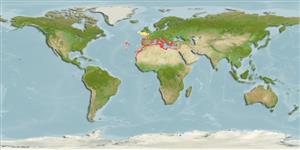>
Scombriformes (Mackerels) >
Centrolophidae (Medusafishes)
Etymology: Schedophilus: Name from Greek words 'phylos' (Φίλος), t) meaning 'one who likes' and "s 'shedia' (Σχεδία) which means raft; literally means 'the one who likes rafts'. This probably refers to the lifestyle ot the juveniles of this genus (Michail Ragousis, mar10091@marine.aegean.gr, pers. Comm. 01/16) which are epipelagic and associate with floating jellyfish.
More on author: Cuvier.
Environment: milieu / climate zone / depth range / distribution range
Écologie
marin benthopélagique; profondeur 70 - 700 m (Ref. 52180). Subtropical; 52°N - 16°S, 65°W - 36°E
Eastern Atlantic: Spain and throughout most of the Mediterranean southward. Although reported to occur in South Africa (Ref. 4542, 6942), Smith 1995 (Ref. 11228) mentions that the species occurring in southern Africa is not Schedophilus ovalis but Schedophilus velaini. Western Central Atlantic: a small specimen recorded from Bermuda.
Taille / Poids / Âge
Maturity: Lm ? range ? - ? cm
Max length : 100.0 cm TL mâle / non sexé; (Ref. 3596); common length : 60.0 cm TL mâle / non sexé; (Ref. 3596)
Prefers deep water at the edge of continental shelves and around oceanic islands; larger specimens near the bottom (Ref. 4542). Young are epipelagic and associate with floating jellyfish, including Physalia (Ref. 4542). Adults are caught on hooks baited with fish or squid. Its white flesh is reported to be good-tasting (Ref. 4542).
Life cycle and mating behavior
Maturité | Reproduction | Frai | Œufs | Fécondité | Larves
Haedrich, R.L., 1990. Centrolophidae. p. 1011-1013. In J.C. Quero, J.C. Hureau, C. Karrer, A. Post and L. Saldanha (eds.) Check-list of the fishes of the eastern tropical Atlantic (CLOFETA). JNICT, Lisbon; SEI, Paris; and UNESCO, Paris. Vol. 2. (Ref. 6942)
Statut dans la liste rouge de l'IUCN (Ref. 130435: Version 2024-1)
Menace pour l'homme
Harmless
Utilisations par l'homme
Pêcheries: commercial
Outils
Articles particuliers
Télécharger en XML
Sources Internet
Estimates based on models
Preferred temperature (Ref.
123201): 11.8 - 18.8, mean 14.8 °C (based on 221 cells).
Phylogenetic diversity index (Ref.
82804): PD
50 = 0.5039 [Uniqueness, from 0.5 = low to 2.0 = high].
Bayesian length-weight: a=0.00832 (0.00410 - 0.01689), b=3.10 (2.91 - 3.29), in cm total length, based on LWR estimates for this species & (Sub)family-body (Ref.
93245).
Niveau trophique (Ref.
69278): 3.5 ±0.47 se; based on food items.
Résilience (Ref.
120179): Faible, temps minimum de doublement de population : 4,5 à 14 années (Preliminary K or Fecundity.).
Fishing Vulnerability (Ref.
59153): High vulnerability (60 of 100).
Climate Vulnerability (Ref.
125649): Moderate vulnerability (39 of 100).
Nutrients (Ref.
124155): Calcium = 28.7 [14.5, 52.1] mg/100g; Iron = 0.619 [0.372, 1.095] mg/100g; Protein = 18 [16, 20] %; Omega3 = 0.279 [0.157, 0.489] g/100g; Selenium = 58.3 [26.8, 121.8] μg/100g; VitaminA = 7.9 [2.0, 32.3] μg/100g; Zinc = 0.544 [0.377, 0.841] mg/100g (wet weight);
